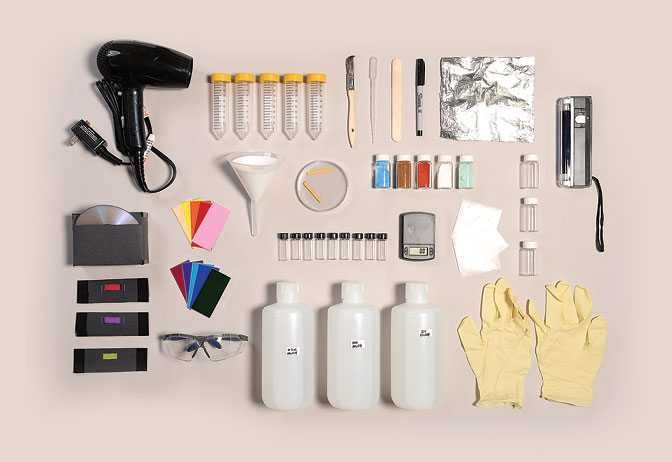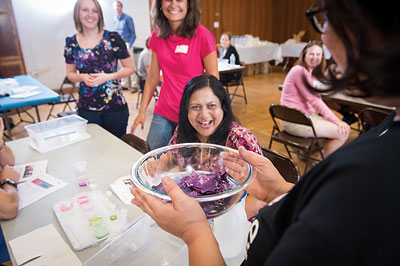

Items from DNAZone’s “Chemistry of Color: Pigments in Art” classroom kit. The kit, which is available to Pittsburgh-area teachers, is fully stocked with materials for both teacher demonstrations and student experiments.
Getting Hands-On With Science
DNAZone, an MCS outreach program, brings lab experiments into Pittsburgh schools through its Classroom Kit Lending Library
by Hannah Diorio-Toth
When Pittsburgh Science and Technology Academy teacher Craig Kozminski introduced his 9th grade class to the topic of acids and bases, he used a kit from DNAZone’s Classroom Kit Lending Library to augment his lesson. Taking out several clear vials of liquid from a large bin and setting them on his lab table, he started with one question: “What would cause these solutions to change color?”
DNAZone, an educational outreach program organized by Carnegie Mellon University’s Center for Nucleic Acids Science and Technology (CNAST), lends kits like “What is the pH? Chemistry of Acids and Bases” and “Kitchen Chemistry: Edible Emulsions” to local science teachers in an effort to bring life to the scientific concepts that students are learning in the classroom.
Kozminski’s students divided up into groups of two or three and turned to the small boxes of materials in front of them for an answer. Inside each box they found the same items that Kozminski had asked them about: vinegar, lemon juice, and milk of magnesia. They also found several small plastic cups in which they were asked to individually pour their various liquids.
“The students were given no background information about pH besides whatever prior knowledge they were bringing to the table. Instead, we put things in the hands of the students first and then asked them to make discoveries,” explains Kozminski.

Catalina Achim shows teachers how to use red cabbage to make a ph indicator at a DNAZone teacher workshop in August.
After adding a homemade pH indicator made from boiled red cabbage to their samples, the students discovered that their original liquids had changed into a rainbow of vibrant colors. They then matched these colors to a pH scale, which revealed whether their liquids were acidic, basic, or neutral.
This type of learning, called inquiry-based learning, is used in many Pittsburgh-area schools and in schools across the country. The hands-on activities in DNAZone’s lending library are designed to support this inquiry-based learning by challenging students to answer fundamental scientific questions or solve real-world problems.
“Our goal is to make learning science fun and engaging. We are inspired and informed by the research that we do and we want to pass that excitement to the students,” says Professor of Chemistry and DNAZone Outreach Coordinator Catalina Achim.
The classroom kits, created by CNAST faculty members and students, are available to local middle school and high school teachers at no cost. They come with suggested lesson plans and activities that help students develop questions, make observations, and analyze their results. Students learn by doing—much like they would in professional scientific research.
“The lending library shows teachers that they don’t have to create everything, but instead can leverage the resources around them,” explains Pittsburgh Public School Science Coordinator Rhonda Graham.
One of those resources is the undergraduate and graduate students in CNAST. Several student volunteers develop new classroom kits throughout the year with the support and guidance of DNAZone and with resources like CMU’s Leonard Gelfand Center for Service Learning and Outreach. They also take the kits on the road to local schools and other local community and educational centers.
“The younger the mentor is, the greater the connectivity,” says Professor of Biology and CNAST Co-Director John Woolford. “I think the fact that we have undergraduate students and graduate students working on outreach together with faculty is really fantastic, because the CNAST students are relatable and very clearly show what it looks like to be excited about science.”
Chemistry graduate students Taylor Canady and Genoa Warner recently created a kit that explains the basic rules of DNA property and function using a unique ribbon model and used it with students at several outreach events this year.
“Given some time, the students are asking questions like, ‘Does DNA bind to itself on the same strand?’ or ‘How do these buttons (which represent the nucleobases), make life happen?’ ” explains Canady. “I find these unguided bursts of inquisition truly exciting to see firsthand.”
Sparking scientific questions like these has fueled DNAZone since its creation in 2008. The program was founded on the goal of giving children, who may not have access to the proper resources, the opportunity to learn the experimental aspects of the sciences.
“We all felt that an outreach program to educate the public was inherently valuable, especially at a time when science literacy rates seem to fall daily,” says Professor of Chemistry and CNAST Co-Director Bruce Armitage. “Getting young people excited about science and making them life-long appreciators, if not practitioners, of science has always been really important to us.”
The program reached about 300 students in 2014 through demonstrations and outreach events alone, but the DNAZone team decided to ramp up development of its lending library in an effort to increase their impact in the Pittsburgh area. Achim is confident that the classroom-kit model will allow for an even larger educational footprint.
“We thought about how we could give the lessons that we created a life of their own,” explains Achim, “We found that we could empower teachers by directly providing them with the materials from our activities. By doing this, we could reach more people.”
Just as Achim hoped, the lessons take on a life of their own each time a kit is borrowed by a teacher. As the kits leave Mellon Institute and are welcomed into a new classroom, they become a platform for teachers and students to create and innovate. The kits are simply a catalyst for one of CNAST’s favorite reactions—learning.